|
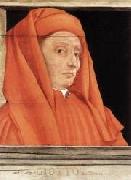 |
GIOTTO di Bondone
|
|
Italian Early Renaissance Painter, 1267-1337
Italian painter and designer. In his own time and place he had an unrivalled reputation as the best painter and as an innovator, superior to all his predecessors, and he became the first post-Classical artist whose fame extended beyond his lifetime and native city. This was partly the consequence of the rich literary culture of two of the cities where he worked, Padua and Florence. Writing on art in Florence was pioneered by gifted authors and, although not quite art criticism, it involved the comparison of local artists in terms of quality. The most famous single appreciation is found in Dante's verses (Purgatory x) of 1315 or earlier. Exemplifying the transience of fame, first with poets and manuscript illuminators, Dante then remarked that the fame of Cimabue, who had supposed himself to be the leader in painting, had now been displaced by Giotto. Ironically, this text was one factor that forestalled the similar eclipse of Giotto's fame, which was clearly implied by the poet. |
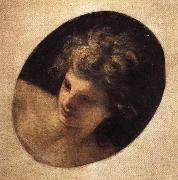 |
Gian Lorenzo Bernini
|
|
Italian sculptor , b. 1598, Napoli, d. 1680, Roma
,Italian architect and artist credited with creating the Baroque style of sculpture. He began his career working for his father, a sculptor. Among his early sculptures are Apollo and Daphne (1622 -C 24) and an active David (1623 -C 24). Under the patronage of Urban VIII, the first of eight popes he was to serve, he created the baldachin over the tomb of St. Peter in Rome. Bernini's architectural duties increased after 1629, when he was appointed architect of St. Peter's Basilica and the Palazzo Barberini. His works often represent a fusion of architecture and sculpture, as in the Cornaro Chapel, in Santa Maria della Vittoria, Rome, with its celebrated theatrical sculpture, The Ecstasy of St. Teresa (1645 C 52). His greatest architectural achievement is the colonnade enclosing the piazza before St. Peter's. |
 |
giacomo balla
|
|
Balla is often portrayed as a painter closely associated with Italian Futurism although in fact, like a number of others associated with the group, his work crossed into a number of creative disciplines including fashion and the applied arts. In 1914 he wrote the Manifesto on Menswear, later retitled Antineutral Clothing, a dramatic exhortation to dispense with the mundaneity of everyday menswear in favour of dynamic, expressive, and aggressive Futurist clothing. Like his fellow Futurists he sought to sweep away all vestiges of Italy cultural heritage in favour of an emphatically 20th-century way of life. He conceived of Futurist menswear as allowing its wearers to respond to mood changes through pneumatic devices that can be used on the spur of the moment, thus everyone can alter his dress according to the needs of his spirit. It could also be animated by electric bulbs. He had an exhibition at the Casa DArte Bragaglia in Rome in 1918, in conjunction with which he co-published his Colour Manifesto. He was also committed to Futurist applied arts and furniture, brightly painted and with richly animated surfaces, and showed them at his Futurist House in 1920, the year in which he collaborated on the journal Roma futurista. He also exhibited at the Paris Exposition des Arts D??coratifs et Industriels of 1925 and the International Exhibition at Barcelona in 1929. However he failed to get his Futurist designs put into mass production and during the 1930s gradually distanced himself from such an outlook. |
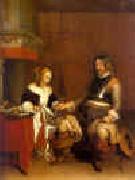 |
Gerard Ter Borch
|
|
1617-1681
Dutch
Gerard Ter Borch Locations
Gerard Ter Borch was born in Zwolle. His first teacher was his father, Gerard Ter Borch the Elder, who in his youth had spent some years in Rome and returned with drawings he had made as well as some he had collected in Italy. The son precociously revealed his gifts as a draftsman, as shown in his drawing of a man on horseback (1625).
Ter Borch traveled widely. In 1634 he was in Haarlem, in 1635 in London, in 1640 probably in Rome. A visit to Spain is reflected in reminiscences of Diego Velazquez in the style and psychological penetration of Ter Borch s portraits. His famous portrait Helena van der Schalke as a Child (ca. 1644) calls to mind Velazquez s Infantas; the placement of the figure in palpable yet undefined space, without the indication of a floor line, is a masterful adoption of the Spanish masters invention.
Between 1645 and 1648 Ter Borch was in Munster, Germany, where he went to seek portrait commissions during the meetings that ended the 80 years of war between the United Provinces and Spain. His small group portrait Swearing of the Oath of Ratification of the Treaty of Munster is a rare example in Dutch 17th-century painting of the recording of an actual historical event. It includes more than 50 recognizable portraits. The painter asked for this work the enormous price of 6, 000 guilders. Apparently no buyer was found, for the picture was in the hands of his widow after his death. From 1654 on Ter Borch lived mainly in Deventer, where he married, became a citizen, held honorary office, and died on Dec. 8, 1681.
Ter Borch s early paintings were mainly scenes of military life, painted with great subtlety of color and values. Later he showed a predilection for small, dainty interior scenes, in which he revealed his delight in the sheen of satin and the grace of charming women. The elegance of his figures has tended to obscure the fact that in many cases they are shown as participants in situations of amatory commerce. The figures and costumes are painted with care and high finish that is not matched in the settings and backgrounds, which are often not well realized. The Music Lesson (ca. 1675) is a characteristic late example of Ter Borchs favorite subject matter. His most able pupil, Caspar Netscher, became a successful portraitist in the small-scale and fashionable tradition of his master. |
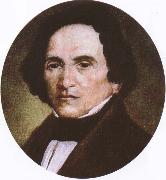 |
georges bizet
|
|
Born: Oct 25, 1838 in Paris, France
Died: Jun 03, 1875 in Bougival, France
Active: '30s, '50s, '70s-2000s
Major Genres: Music, Theater
Career Highlights: Carmen, Carmen Jones, Carmen
First Major Screen Credit: The Burlesque on Carmen (1916)
|
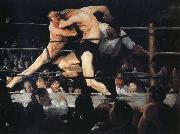 |
George Wesley Bellows
|
|
American Ashcan School Painter, 1882-1925
American painter and lithographer. He was the son of George Bellows, an architect and building contractor. He displayed a talent for drawing and for athletics at an early age. In 1901 he entered Ohio State University, where he contributed drawings to the school yearbook and played on both the basketball and baseball teams. In spring of his third year he withdrew from university to play semi-professional baseball until the end of summer 1904 |
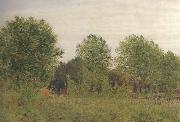 |
George Price Boyce.RWS
|
|
1826-1897
English painter. He was the son of a prosperous wine merchant and pawnbroker. His childhood was spent in London, and in 1846 he was apprenticed to the firm of architects Wyatt & Brandon, where he remained for three years. He was always fascinated by ancient buildings but gradually lost interest in architecture as a career. In 1849, perhaps as a result of meeting David Cox at Betws-y-Coed (Gwynedd, Wales), he decided to become a painter. In the early 1850s Boyce drew landscape and architectural subjects with a fluent watercolour technique derived from Cox. In 1854 Boyce made an extended journey to Italy; he painted views of buildings in Venice and Verona, which were commended by Ruskin, and semi-abstract twilight studies |
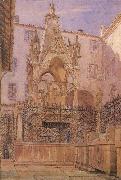 |
George Price Boyce,RWS
|
|
1826-1897
English painter. He was the son of a prosperous wine merchant and pawnbroker. His childhood was spent in London, and in 1846 he was apprenticed to the firm of architects Wyatt & Brandon, where he remained for three years. He was always fascinated by ancient buildings but gradually lost interest in architecture as a career. In 1849, perhaps as a result of meeting David Cox at Betws-y-Coed (Gwynedd, Wales), he decided to become a painter. In the early 1850s Boyce drew landscape and architectural subjects with a fluent watercolour technique derived from Cox. In 1854 Boyce made an extended journey to Italy; he painted views of buildings in Venice and Verona |
 |
George Loring Brown
|
|
American Hudson River School Painter, 1814-1889,American painter and illustrator. He was apprenticed at about 14 to the Boston wood-engraver Alonzo Hartwell and had produced scores of illustrations by 1832, when he turned to painting and sailed to Europe for further training. After brief stays in Antwerp and London, he settled in Paris, where he was admitted to the atelier of Eugene Isabey. Returning to America in 1834, Brown produced illustrations, portraits and landscapes. He travelled throughout the north-eastern USA, sketching in watercolour and in oil. |
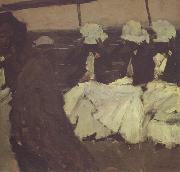 |
George Hendrik Breitner
|
|
Dutch Painter, 1857-1923
Dutch painter and photographer. He trained as a painter and draughtsman at the academy in The Hague. Although the Dutch painter Charles Rochussen taught the students history and landscape painting, Breitner's interests did not lie in this area. In 1880 he worked for a year in the studio of Willem Maris after his academy training. Maris belonged to the Hague school of painters, who worked in the plein-air tradition of the French Barbizon school. Breitner painted outdoor life with them, although it was not the picturesqueness of the landscape or the Dutch skies that appealed to him. With Van Gogh he roamed the working-class districts of The Hague and through the dockyards of Rotterdam. Both artists recorded the vitality of city life in their sketchbooks. Breitner consciously chose these themes and motifs: he wanted to paint people going about their daily lives |
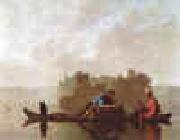 |
George Caleb Bingham
|
|
1811-1879
George Caleb Bingham Gallery
George Caleb Bingham (March 20, 1811 ?C July 7, 1879) was an American artist, whose work depicted his view of American life in the frontier lands along the Missouri River. Left to languish in obscurity, Bingham's work was rediscovered in the 1930s and he is now widely considered one of the greatest American painters of the 1800s.
Born in Augusta County, Virginia, Bingham was the second of seven children born to Henry Vest Bingham and Mary Amend. Upon their marriage, Matthias Amend, Mary's father, gave ownership to the family mill, 1,180 acres of land and several slaves to Henry with the agreement that Matthias could live with the family the rest of his life. Henry offered the land and mill as surety for a friend's debt and, when the friend died in 1818, all was lost. George's family soon moved to Franklin, Missouri "where the land was said to be bountiful, fertile and cheap."
Bingham was a self-taught artist. His sole childhood exposure to the field was as a nine-year-old boy, when famed American portraitist Chester Harding visited Franklin looking for business, having recently sketched Daniel Boone in Warren County, Missouri. George assisted Harding during his brief stay, an experience that left a powerful impression.
In 1823, Bingham's father, now judge of Howard County Court, died of malaria on December 26 at the age of thirty-eight. To keep the family going, Mary Bingham opened a school for girls and George, then twelve, worked as school janitor to help keep the family afloat. At age sixteen, Bingham apprenticed with cabinet maker Jesse Green. After Green moved, he apprenticed with another cabinet maker, Justinian Williams. Both tradesmen were Methodist ministers and, while under their tutelage, Bingham studied religious texts, preached at camp meetings and thought about becoming a minister himself. Bingham also considered becoming a lawyer.
However, by age nineteen, Bigham was painting portraits for $20.00 apiece, often completing the works in a single day. He drummed up work in both Franklin and Arrow Rock and, while his painting abilities were still developing, succeeded in impressing his patrons with his strong draftsmanship and ability to capture the likeness of his subject. Soon Bingham attempted to travel to St. Louis to ply his trade but contracted measles, which left him weak and permanently bald.
In 1836, Bingham married Sarah Elizabeth Hutchison, who bore him three children over the subsequent twelve years before dying at the age of twenty-nine. George married twice more, first to Eliza Thomas, who died in a mental institution in 1876, and then to Martha Lykins, who lived until 1890. George's mother, Mary, died in 1851.
By 1838, Bingham was already beginning to make a name for himself as a portrait artist in St. Louis, his studio visited by several prominent local citizens and statesmen, including the lawyer James S. Rollins who was to become a life-long friend. To further his education, George spent three months in Philadelphia, Pennsylvania before continuing on to New York City to visit the National Academy of Design exhibition.
Bingham was elected to the Missouri General Assembly in 1848.
From 1856 to 1859, Bingham studied art with the members of the D??sseldorf School in D??sseldorf, Germany. Critics claim that this caused him to abandon the rustic American style in his art. Upon his return, he began painting less, turning to politics in the post-Civil War years and serving as state treasurer and adjutant general. He was also president of the Board of Police Commissioners for Kansas City, Missouri in 1874, appointing the first chief of police there . Toward the end of his life he was a professor of art at the University of Missouri in Columbia, Missouri. |
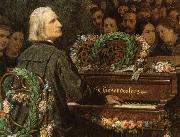 |
george bernard shaw
|
|
Born: 26 July 1856
Birthplace: Dublin, Ireland
Died: 2 November 1950 (natural causes)
Best Known As: The author of Pygmalion |
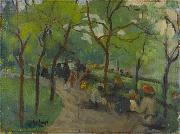 |
George Benjamin Luks
|
|
(August 13, 1867-October 29, 1933) was an American realist artist and illustrator. His vigorously painted genre paintings of urban subjects are examples of the Ashcan school in American art.
Luks was born in Williamsport, Pennsylvania, to Central European immigrants. His father was a physician and his mother was an amateur painter and musician.The Luks family (George, his parents and five siblings) eventually moved to Pottsville, in Southern Pennsylvania near the coal fields. In this setting, he learned at a young age the importance of compassion by watching how his parents helped the coal miners' families, and many believe that this is the reason why lower class New Yorkers were often Luks's subject matter. Luks studied at the Pennsylvania Academy of Fine Arts before he traveled though Europe where he attended several art schools. Later he went to Desseldorf where he lived with a distant relative, a retired lion-tamer. He abandoned Desseldorf for the more stimulating spheres of London and Paris. He then returned to Philadelphia in 1893 where he was an illustrator for the Philadelphia Press where he met John Sloan, William Glackens, and Everett Shinn. They would meet at the studio of Robert Henri, an artist who emphasized the depiction of ordinary life, shunning genteel subjects and painting quickly. The group became known as the "Philadelphia Five". In 1896, Luks moved to New York and began his art career there as the premier humorist artist for the New York World. During his time as an illustrator there, he lived with William Glackens. |
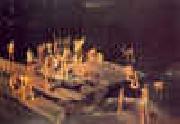 |
George Bellows
|
|
1882-1925
Growing prestige as a painter brought changes in his life and work. Though he continued his earlier themes, Bellows also began to receive portrait commissions, as well as social invitations, from New York's wealthy elite. Additionally, he followed Henri's lead and began to summer in Maine, painting seascapes on Monhegan and Matinicus islands.
At the same time, the always socially conscious Bellows also associated with a group of radical artists and activists called "the Lyrical Left", who tended towards anarchism in their extreme advocacy of individual rights. He taught at the first Modern School in New York City (as did his mentor, Henri), and served on the editorial board of the socialist journal, The Masses, to which he contributed many drawings and prints beginning in 1911. However, he was often at odds with the other contributors because of his belief that artistic freedom should trump any ideological editorial policy. Bellows also notably dissented from this circle in his very public support of U.S. intervention in World War I. In 1918, he created a series of lithographs and paintings that graphically depicted the atrocities committed by Germany during its invasion of Belgium. Notable among these was The Germans Arrive, which was based on an actual account and gruesomely illustrated a German soldier restraining a Belgian teen whose hands had just been severed. However, his work was also highly critical of the domestic censorship and persecution of anti-war dissenters conducted by the U.S. government under the Espionage Act. |
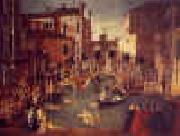 |
Gentile Bellini
|
|
Italian
c1429-1507
Gentile Bellini Gallery
(b Venice, ?1429; d Venice, 23 Feb 1507). Painter and draughtsman, son of (1) Jacopo Bellini. An official painter of the Venetian Republic, he was a dominant figure in Venetian art for several decades in the latter half of the 15th century, known particularly for portraits and large narrative paintings in which the city and its inhabitants are depicted in great detail. |
 |
Fritz Zuber-Buhler
|
|
was a Swiss painter integrant of the style Academic Classicism, born in 1822 at Le Locle in Switzerland and died November 23, 1896.
At sixteen years old he moved to Paris, France where found his first teacher Louis Grosclaude. Later he studied at the École des Beaux-Arts and then refined his technical skills with François-Édouard Picot, who followed the same lineage of contemporaneous artists such as Leon Perrault, Bouguereau, Alexandre Cabanel and many others. Afterwards he spent some time in Italy searching for inspiration and raise the quality of his art. Then, returning to Paris, he made his debut at the Salon in 1850 exhibiting alongside oil paintings, drawings, pastels and watercolors.
His painting Innocence shows his romantic view of the peasant childhood and their environments, expressing nature, softness and intense details. Also his works were drawn by popular themes at that period like mythology, religion and requested portraits. Zuber-Buhler produced exhibitions in the United States, comprising at the Pennsylvania Academy of the Fine Arts and achieved great admiration as a classic academic painter. |
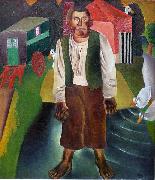 |
Frits Van den Berghe
|
|
(3 April 1883 - 22 September 1939) was a Belgian expressionist painter.
He was born at Ghent. Like his friends Constant Permeke and Gustave De Smet, he first adopted the late-impressionist style of Emile Claus, but converted to expressionism during World War I.
|
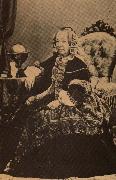 |
fredrika bremer
|
|
was a Swedish writer and a feminist activist.
Fredrika Bremer was born in Åbo (Turku) in Finland but moved with her family to Stockholm when she was three years old. She grew up in Stockholm and in the manor Årsta outside Stockholm. Her father was described as somewhat of a house tyrant, and her mother was a socialite, and she and her sisters where brought up to marry in to the aristocracy; a trip on the continent 1821-1822 was the finishing touch of her upbringing before her debute.
Bremer was not comfortable with this role, and was inflicted by a crisis, which she overcame by charitable work in the country around Årsta. In 1828, she debuted as a writer, anonomously, with a series of novels published until 1831, and was soon followed by others. Her novels were romantic stories of the time and concentrates on women in the marriage market; either beautiful and superficial, or unattractive with no hope of joining it, and the person telling the story and watching them is often an independent woman. She wanted a new kind of family life, not focused only on the men of the family, that would allow for women to develop their own talents and personality. By the 1840s, she was an acknowledged part of the culture life in Sweden and was translated to many languages. Politically, she was a liberal, but also felt symphaty for the socialism of the English working class movement |
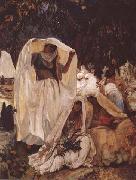 |
Frederick Arthur Bridgman
|
|
American Painter, 1847-1928
was an American artist, born in Tuskegee, Alabama. An American Southerner, born in Tuskeegee, Alabama, the son of a physician, Bridgman would become one of the United States' most well-known and well-regarded painters and become known as one of the world's most talented "Orientalist" painters. He began as a draughtsman in New York City, for the American Bank Note Company in 1864-1865, and studied art in the same years at the Brooklyn Art Association and at the National Academy of Design; but he went to Paris in 1866 and became a pupil of Jean-Leon Gerôme. Paris then became his headquarters. A trip to Egypt in 1873-1874 resulted in pictures of the East that attracted immediate attention, and his large and important composition, The Funeral Procession of a Mummy on the Nile, in the Paris Salon (1877), bought by James Gordon Bennett, brought him the Cross of the Legion of Honor. Other paintings by him were An American Circus in Normandy, Procession of the Bull Apis (now in the Corcoran Gallery of Art, Washington, D.C.), and a Rumanian Lady (in the Temple collection, Philadelphia, Pennsylvania). In 1867, Bridgman entered the studio of the noted academic painter Jean-Leon Gerôme (1824-1904), where he was deeply influenced by Gerôme's precise draftsmanship, smooth finishes, and concern for Middle-Eastern themes. (Bridgman would even become known as "the American Gerôme.") No mere imitator, however, Bridgman would later adopt a more naturalistic aesthetic, emphasizing bright colors and painterly brushwork. Bridgman made his first trip to North Africa between 1872 and 1874, dividing his time between Algeria and Egypt. There he executed approximately three hundred sketches, which became the source material for several later oil paintings. Additional visits to the region throughout the 1870s and 1880s allowed him to amass a collection of costumes, architectural pieces, and objets d'art, which often appear in his paintings. (Amusingly, John Singer Sargent noted that Bridgman's overstuffed studio, along with the Eiffel Tower, were Paris's must-see attractions.) Though Bridgman maintained a lifelong connection to France, his popularity in America never waned. Indeed, in 1890, the artist had a one-man show of over 400 pictures in New York's 5th Avenue galleries. When the show moved to Chicago's Art Institute, it contained only 300 works - testimony to the high number of sales Bridgman had made. |
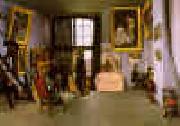 |
Frederic Bazille
|
|
b.Dec. 6, 1841, Montpellier, France
d.Nov. 28, 1870, Beaune-la-Rolande
French
Frederic Bazille Galleries
was a French Impressionist painter best known for his depiction of figures.
Born in Montpellier, Herault, Languedoc-Roussillon, into a middle-class Protestant family, Bazille became interested in painting after seeing some works of Eugene Delacroix. His family agreed to let him study painting, but only if he also studied medicine.
Bazille began studying medicine in 1859. He moved to Paris in 1862 to continue his studies. There he met Pierre-Auguste Renoir, was drawn to Impressionist painting, and began taking classes in Charles Gleyres studio. After failing his medical exam in 1864, he began painting full-time. His close friends included Claude Monet, Alfred Sisley, and Édouard Manet. Born to a wealthy family, Bazille helped support some of these artists by giving them space in his studio and materials to use.
Bazille was just twenty-three years old when he painted several famous works, including The Pink Dress. His best known painting is Family Reunion (1867?C1868). |
 |
Frederic Auguste Bartholdi
|
|
French Sculptor, 1834-1904,was a French sculptor. He is also known as Amilcar Hasenfratz, a pseudonym used for his paintings of Egyptian subjects, apparently because of concern that his work in another medium would distract from his sculpture. Born in Colmar, Alsace, Bartholdi went to Paris to further his studies in architecture as well as painting. Then he made a long trip to Egypt and Yemen, where he heard about the Suez project. He came back to his native city to become an architect. Bartholdi was a freemason, he was initiated on October 14, 1875 in the lodge LeAlsace-Lorraine, Grand Orient of France. |
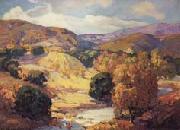 |
Franz Bischoff
|
|
Austrian-born American Painter, 1864-1929
was an American artist known primarily for his beautiful floral paintings and California landscapes. He was born in Bomen, Austria on January 9, 1864 and as a young teenager immigrated to the United States where he became a naturalized citizen. While in Europe, his early training was focused upon applied design, watercolor and ceramic decorations.After having lived and worked in New York, Fostoria, Ohio and Dearborn, Michigan, Franz Bischoff decided to visit California in 1900 and ultimately chose to settle in Los Angeles in 1906. Shortly after arriving, he started making arrangements to design and build a large Italian Renaissance style home in Pasadena that also became his studio. This landmark home was completed in 1908. Inspired by the California countryside, Bischoff set attempted to capture the area's brilliant light and diverse landscapes. Spending less time with ceramic painting, Bischoff painted local farms, fishing wharfs, and coastal landscapes. Recognized during his career for use of color and vivid composition, his paintings always displayed reverence for nature. One critic commented that some of his later works flirted with Expressionism and his use of colors were reminiscent of Fauvism. |
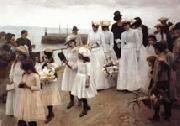 |
Frank Bramley
|
|
English Painter, 1857-1915
was a British post-impressionist painter of the Newlyn School. Bramley studied at the Lincoln School of Art from 1873 to 1878, later at the Royal Academy of Fine Arts Antwerp from 1879 to 1882. After staying in Venice from 1882 to 1884, he moved to the Newlyn School artist colony in Cornwall. Bramley worked on combining natural and artificial light in his paintings. His A Hopeless Dawn (1888) was bought by the Tate gallery. He married artist Katherine Graham in 1891. |
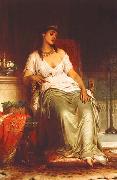 |
Frank Bernard Dicksee
|
|
(b. London, 27 November 1853 - 17 October 1928) was an English Victorian painter and illustrator, best known for his pictures of dramatic historical and legendary scenes. He also was a noted painter of portraits of fashionable women, which helped to bring him success in his own time.
Dicksee's father, Thomas Dicksee, was a painter who taught Frank as well as his brother Herbert and his sister Margaret from a young age. Dicksee enrolled in the Royal Academy in 1870 and achieved early success. He was elected to the Academy in 1891 and became its President in 1924. He was knighted in 1925, and named to the Royal Victorian Order by King George V in 1927.
Dicksee painted the piece 'The Funeral of a Viking' in 1893, which now resides in Manchester City Art Gallery, having been there since 1928 when it was presented by Arthur Burton ESQ in memory of his mother to the Corporation of Manchester. Victorian critics gave it both positive and negative reviews, for its perfection as a showpiece and for its dramatic and somewhat staged setting, respectively. The painting was used by Swedish Viking/Black metal band Bathory for the cover of their 1990 album, Hammerheart.
|
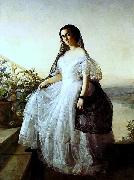 |
Francois-Auguste Biard
|
|
(June 30, 1799 - June 20, 1882) was a French genre painter.
Born at Lyon, he traveled around the world, sketching on the way. He was particularly successful in rendering burlesque groups.
His painting, Scenes on the Coast of Africa, depicted on the right, was the inspiration behind Isaac Julien's short film The Attendant (1993). Biard was a known abolitionist against the Atlantic slave trade.
Wikimedia Commons has media related to: Auguste François Biard
This article incorporates text from the public domain 1907 edition of The Nuttall Encyclopædia.
|
 |
Francois Boucher
|
|
French Rococo Era Painter, 1703-1770
Francois Boucher seems to have been perfectly attuned to his times, a period which had cast off the pomp and circumstance characteristic of the preceding age of Louis XIV and had replaced formality and ritual by intimacy and artificial manners. Boucher was very much bound to the whims of this frivolous society, and he painted primarily what his patrons wanted to see. It appears that their sight was best satisfied by amorous subjects, both mythological and contemporary. The painter was only too happy to supply them, creating the boudoir art for which he is so famous.
Boucher was born in Paris on Sept. 29, 1703, the son of Nicolas Boucher, a decorator who specialized in embroidery design. Recognizing his sons artistic potential, the father placed young Boucher in the studio of François Lemoyne, a decorator-painter who worked in the manner of Giovanni Battista Tiepolo. Though Boucher remained in Lemoynes studio only a short time, he probably derived his love of delicately voluptuous forms and his brilliant color palette from the older masters penchant for mimicking the Venetian decorative painters. |
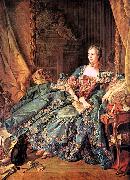 |
Francois Boucher
|
|
François Boucher (29 September 1703 - 30 May 1770) was a French painter, a proponent of Rococo taste, known for his idyllic and voluptuous paintings on classical themes, decorative allegories representing the arts or pastoral occupations, intended as a sort of two-dimensional furniture. He also painted several portraits of his illustrious patroness, Madame de Pompadour.
|
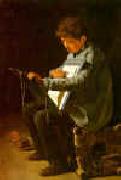 |
Francois Bonvin
|
|
1817-1887
French
Francois Bonvin Location
Bonvin was born in humble circumstances in Paris, the son of a police officer and a seamstress. When he was four years old his mother died of tuberculosis and young Francois was left in the care of an old woman who underfed him. Soon his father married another seamstress and brought the child back into the household. Nine additional children were born, putting a strain on the familys resources, and to make matters worse his stepmother took to abusing and undernourishing Francois.
The young Bonvin started drawing at an early age. His potential was recognized by a friend of the family, who paid for him to attend a school for drawing instruction at age eleven. This instruction ended after two years, when his father apprenticed him to a printer, and Bonvin was to remain mostly self-taught as an artist. He spent his free time at the Louvre where he especially appreciated the Dutch old masters. Bonvin married a laundress at the age of twenty, at about the same time that he secured a job at the headquarters of the Paris police. It was during this period in his life that he also contracted an illness which would trouble him for the rest of his life.
Bonvin exhibited three paintings in the Salon of 1849, where he was awarded a third-class medal. He exhibited in the Salon of 1850 with Courbet, and won recognition as a leading realist, painting truthfully the lives of the poor which he knew at first hand. His paintings were well received by critics and by the public. Although his work had elements in common with Courbets, his modestly scaled paintings were not seen as revolutionary. He was awarded the Legion d honneur in 1870.
His subjects were still life and the everyday activities of common people, painted in a style that is reminiscent of Pieter de Hooch and Jean-Baptiste-Simeon Chardin. It is the latter who is especially recalled by Bonvins delicate luminosity.
In 1881 he underwent an operation which did not restore him to health, and he became blind. A retrospective exhibition of his work was held in 1886. He died at Saint-Germain-en-Laye in 1887. |
 |
Francois Bocion
|
|
1828-1890
was a Swiss artist and teacher. Born in Lausanne, Bocion studied art there before going to Paris, France in 1845 to study further. Following a bout with typhoid fever, he returned home in 1849. During the early part of his career, Bocion's interest was in the field of illustration as well as in painting historical subjects. However, influenced by the landscapes of Jean-Baptiste Camille Corot, he began painting scenes from around Lake Geneva for which he is best remembered. Bocion eventually secured a professorship at the Lausanne École Industrielle, a position he held for more than forty years. |
 |
Francois Barraud
|
|
14 November 1899 - 11 September 1934) was a Swiss painter.
Barraud was the eldest of four brothers who all painted or sculpted at various points in their lives. The brothers, François, Aime, Aurele and Charles, were largely self-taught artists having been raised as professional plasterers and house painters.Barraud attended evening classes at the local art school in 1911 together with his brothers.In 1919, he exhibited his paintings in La Chaux-de-Fonds and participated in the National Exhibition of Fine Arts in Basel.Encouraged by the success of the exhibitions he left Switzerland in 1922, and moved to Reims in France where he worked as a house painter for two years. He married Marie, a French woman, in 1924. Marie subsequently featured as a model in several of his paintings. Around 1924 or 1925, Barraud found work in Paris as an artist and craftsman. While living in Paris he studied painting at the Louvre.
François Barraud painted mainly still lifes, female nudes and portraits, including several double portraits of himself and his wife, Marie His precise, realist style of painting developed under the influence of the old Flemish and French masters he had studied at the Louvre.
Barraud suffered periods of illness throughout his life and died of tuberculosis in Geneva, in 1934, at the age of 34.
Arthur Stoll held a major collection of François Barraud's works. His works are also held in the Musee des beaux-arts in La Chaux-de-Fonds, the Coninx Museum in Zurich and the Foundation for Art, Culture and History in Winterthur.
|
|

